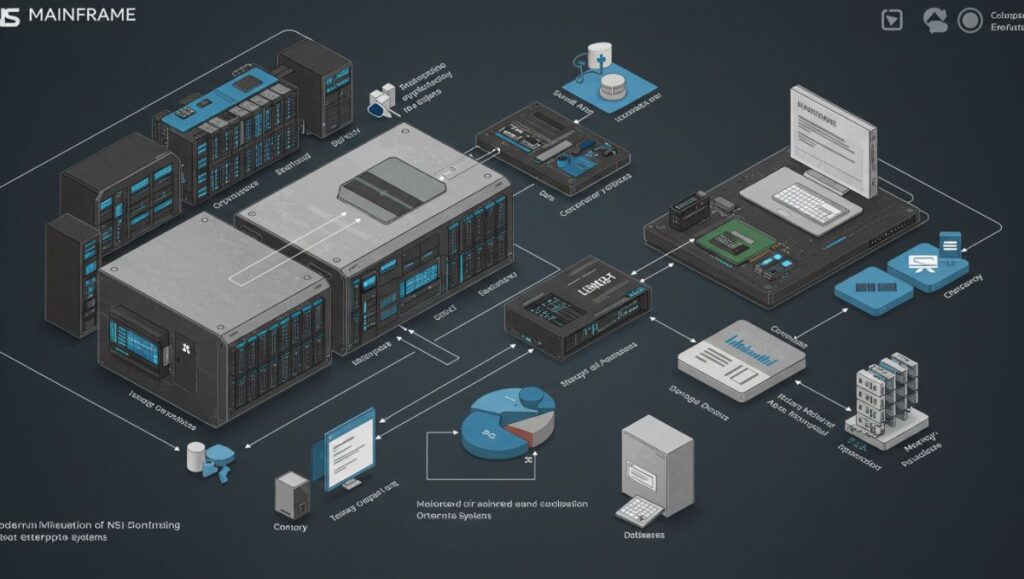In an era dominated by cloud computing, mobile apps, and artificial intelligence, it’s easy to overlook the technology that quietly powers much of the world’s critical data infrastructure: the mainframe. Among the systems that continue to uphold this legacy is the NS Mainframe — a powerful, secure, and highly reliable computing platform designed for handling massive volumes of transactions and data processing.
From banks and airlines to governments and global logistics networks, NS mainframes (Network Server mainframes) remain the trusted foundation for mission-critical applications. This article explores what the NS Mainframe is, how it works, and why it continues to play a key role in modern computing despite the rise of newer technologies.
What Is an NS Mainframe?
The term NS Mainframe generally refers to a Network Server-based mainframe system — a high-performance central computer designed to manage and process large-scale data transactions across connected networks.
Unlike standard servers, mainframes are engineered for reliability, scalability, and continuous uptime, often handling millions of transactions per second. NS mainframes integrate networking capabilities (hence the “NS”) with traditional mainframe architecture, making them suitable for hybrid environments where on-premises computing meets cloud integration.
In simpler terms, an NS mainframe acts as:
-
A centralized data processor for enterprise applications.
-
A transaction management system that ensures real-time accuracy.
-
A secure data hub that connects users, terminals, and applications across networks.
A Brief History of Mainframes
Mainframes have been at the core of enterprise computing since the 1950s, when IBM introduced the first large-scale commercial computers. Over the decades, they evolved from room-sized machines with limited memory to sophisticated, network-enabled platforms that support modern digital ecosystems.
The “NS” (Network Server) era of mainframes emerged as organizations began integrating mainframe computing with distributed networks and internet protocols — allowing these powerful systems to connect seamlessly with desktops, servers, and cloud services.
Today’s NS mainframes combine the stability of legacy mainframes with the flexibility of modern networking technologies, ensuring that organizations can process large workloads without compromising performance or security.
How the NS Mainframe Works
At its core, the NS mainframe functions as a central processing system that supports numerous users and applications simultaneously. Here’s how it operates:
1. Centralized Architecture
Mainframes are designed to centralize data processing. They host databases, applications, and transaction systems that serve thousands (sometimes millions) of users at once.
2. Multi-User and Multi-Tasking Environment
An NS mainframe can run multiple operating systems and workloads concurrently. This is achieved through virtualization, allowing one machine to behave like many.
3. High Throughput and Reliability
NS mainframes can process billions of instructions per second, making them ideal for financial transactions, airline bookings, and government record systems that require nonstop availability.
4. Network Integration
The “NS” component refers to network-based functionality — meaning the mainframe can interact with web servers, databases, APIs, and remote terminals through high-speed, secure connections.
5. Advanced Security
Mainframes offer built-in encryption, role-based access control, and audit trails to protect sensitive enterprise data.
6. Continuous Operation
Unlike standard servers that may require downtime, mainframes are designed for 99.999% uptime, meaning they can operate continuously for years without failure.
Key Features of NS Mainframes
NS mainframes are equipped with advanced features that make them indispensable in enterprise computing environments:
1. Scalability
Mainframes can scale vertically (adding more resources to one system) and horizontally (connecting to other systems) to handle growing workloads.
2. Virtualization Support
They can run multiple virtual servers or “logical partitions” (LPARs), each operating independently with its own OS and applications.
3. Workload Management
Mainframes intelligently prioritize tasks, ensuring that mission-critical applications always receive the necessary resources.
4. Integration Capabilities
NS mainframes easily integrate with modern technologies like cloud platforms (AWS, Azure, IBM Cloud), APIs, and containerized applications (Docker, Kubernetes).
5. Data Security and Compliance
Their architecture supports regulatory compliance for industries such as finance, healthcare, and government, where data integrity is paramount.
6. Long-Term Stability
NS mainframes have an average lifespan of 20–30 years, thanks to modular upgrades and backward compatibility with older software.
Mainframe Operating Systems
Several specialized operating systems power NS mainframes, providing the tools needed for workload management, virtualization, and security. Common examples include:
-
z/OS – IBM’s mainframe operating system for enterprise-level processing.
-
z/VM – Designed for virtualization and running multiple OS instances.
-
Linux on Z – Brings open-source flexibility to mainframe environments.
-
VSE/ESA – Optimized for smaller mainframe installations.
These systems are fine-tuned for transaction-heavy workloads, providing the performance and reliability that modern distributed servers often struggle to match.
Applications of NS Mainframes
Mainframes remain the invisible engines behind some of the world’s most important industries. Their ability to handle massive volumes of data and transactions makes them irreplaceable in several sectors:
1. Banking and Finance
-
Real-time processing of ATM withdrawals, credit card transactions, and stock trades.
-
Securely managing billions in daily transactions.
-
Supporting core banking systems and regulatory compliance.
2. Insurance
-
Processing millions of policies and claims efficiently.
-
Managing customer data and risk models.
3. Government and Defense
-
Storing national databases (such as tax records or census information).
-
Supporting mission-critical defense communications.
4. Healthcare
-
Managing patient records, billing, and research data securely.
-
Ensuring compliance with privacy laws like HIPAA.
5. Transportation and Airlines
-
Handling reservation systems, flight scheduling, and logistics tracking.
6. Retail and E-Commerce
-
Managing supply chain operations, inventory, and transaction processing.
These use cases show that NS mainframes are not outdated relics—they are active, evolving technologies that support billions of daily interactions worldwide.
Benefits of NS Mainframes
Organizations that use NS mainframes continue to do so because of several unmatched advantages:
1. Reliability
Mainframes are designed for continuous operation, ensuring business continuity and minimizing downtime.
2. Performance
They can process thousands of simultaneous transactions without lag, which is crucial for financial and governmental systems.
3. Security
Mainframes provide end-to-end encryption and advanced access control mechanisms, protecting sensitive data from unauthorized access.
4. Cost Efficiency Over Time
Though mainframes are expensive to install initially, their long-term efficiency, scalability, and low maintenance make them cost-effective in the long run.
5. Integration with Modern Systems
Modern NS mainframes can connect with cloud platforms, APIs, and distributed systems, bridging the gap between legacy and modern IT.
6. Proven Track Record
Mainframes have been around for over 60 years, and their consistent evolution proves their adaptability and resilience.
Challenges of Using NS Mainframes
Despite their advantages, NS mainframes also face certain challenges:
1. High Initial Costs
Setting up and maintaining mainframes can be expensive compared to commodity server clusters.
2. Skill Shortage
Mainframe specialists are aging out of the workforce, and there’s a shortage of younger professionals trained in COBOL, JCL, and z/OS.
3. Integration Complexity
Connecting mainframes with newer cloud-based applications can require advanced middleware and networking configurations.
4. Modernization Needs
Organizations must continually invest in mainframe modernization to keep up with evolving technologies like AI, analytics, and blockchain.
The Role of NS Mainframes in the Cloud Era
Many people assume that cloud computing has replaced mainframes—but that’s far from true. Instead, mainframes and cloud systems often coexist in hybrid environments.
For example:
-
Mainframes handle core transactions, while cloud services manage analytics and user interfaces.
-
APIs allow seamless data sharing between mainframe databases and web applications.
-
Containerization tools like Docker on z/OS are bringing cloud-native capabilities to mainframes.
This hybrid model allows businesses to leverage the stability of mainframes with the agility of cloud platforms, ensuring the best of both worlds.
Future of NS Mainframes
Far from being obsolete, the future of mainframes looks promising. Innovations are making them more adaptable and integrated than ever before. Some trends include:
-
AI Integration – Using machine learning for system monitoring and optimization.
-
Mainframe as a Service (MFaaS) – Allowing organizations to access mainframe power via the cloud.
-
Open-Source Compatibility – Running Linux-based and open-source workloads directly on mainframe hardware.
-
Quantum Readiness – Preparing mainframe architectures for integration with future quantum computing technologies.
In short, the NS mainframe is evolving, not disappearing — becoming smarter, more connected, and more indispensable in enterprise computing.
Conclusion
The NS mainframe remains the backbone of modern enterprise IT infrastructure. Its ability to deliver unmatched performance, security, and reliability makes it indispensable in industries where downtime or data breaches are unacceptable.
As businesses continue to embrace digital transformation, NS mainframes are evolving — blending the strengths of traditional computing with the flexibility of cloud and AI technologies. Far from being a relic of the past, the mainframe remains a pillar of the future — silently powering the digital world we depend on every day.






